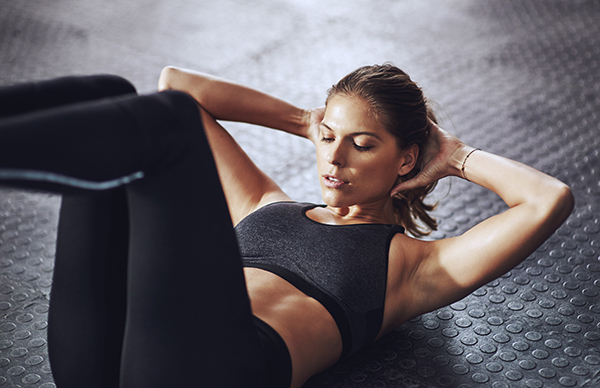Abdominal work is probably not the favorite thing most women do in the gym. Having said that, of all the abdominal exercises that are possible to string together, bench crunches can be enjoyed the most. There is just something satisfying about experiencing the short, intensive contractions, then having them evolve into tingling abdominal muscle cramps, all while knowing that they are shaping toned abs better than almost anything else.
This exercise is so effective because it shortens the fibers of the abdomen and it does so under constant tension throughout the exercise. Some abdominal exercises can excessively stretch the abdominal fibers, and lengthen them, and this can lead to a protruding abdomen when it is relaxed. The other thing I like about bench crunches is that the hips remain bent throughout the contraction. This takes the large psoas major muscle, which is a strong hip flexor, out of the equation. As a result, the anterior abdominal muscles have to carry the entire load of each repetition.
Muscles Used
The rectus abdominis muscle appears to be a long muscle, but it is really a series of short fibers stacked vertically on one another. The linea alba is a thin tendon-like line that creates a groove in the middle of the abdominal wall so the rectus abdominis has a left and right half to it. Typically there are three additional rows of horizontally placed tendons running across the rectus abdominis. These create the abdominal “blocks” that provide the “six-pack” look on the abdominal wall. The fibers of the rectus abdominis run from one horizontal tendinous insertion to the next.
When the rectus abdominis is tensed, the short fibers bulge between the tendinous grooves, almost like small ropes or blocks. If both the right and left halves of this muscle contract, the trunk is simply flexed forward so that the head and chest move closer to the hips and legs (assuming a fixed pelvis). Although there is muscle activity in all of the blocks during most abdominal exercises, the upper two rows are preferentially contracted and shorten the most when doing seated abdominal machine crunches.
Both the external and internal oblique muscles on each side of the abdomen are strongly activated by crunches with the heels on a bench. The external oblique muscle runs from the lower ribs by small bundles of muscle fibers from lateral to medial. The external oblique unites with other slips of muscle fibers to anchor on the iliac bones of the pelvis and hip structure and also the linea alba. When both left and right sides of the external oblique muscles work together, they flex the trunk and move the head toward the feet.
The internal oblique muscle sits just deep to the external oblique muscle. Even though it is not visible, its shape and function make important contributions to the overall abdominal network. It attaches to the thoracolumbar fascia, a thick connective tissue sheath in the lower back. Its fibers run around the side of the trunk at right angles to the external oblique muscle and it attaches on the lowest three or four ribs. Similar to the external oblique muscle, the internal oblique flexes the trunk at the waist and moves the head toward the feet, if both left and right portions contract together.
Bench Crunches
1. Lie on your back on the floor at right angles to a bench. Place your feet on the bench, and bend your knees to 90°. Cross your arms loosely across your chest.
2. Lift your hips just slightly from the floor to contract the lower part of the abdomen.
3. Exhale as you lift (curl) your upper body (shoulders and mid-back) from the floor. Curl your shoulders forward in a slow, deliberate manner (i.e., not fast or jerky) and tuck your chin to your chest as you come upward. This will help to get you into the practice of a curling type of crunch. You do not want to come upward like a flat board, because this does not cause enough shortening of the fibers in your abdomen. Hold the top position for a count of two.
4. Slowly return to the starting position by uncurling your shoulders and upper body, and inhaling as you come down. Let your hips come down toward the floor. However, do not pause or rest once you get to the starting position, but immediately lift your hips, curl your upper body forward and resume the crunch part, by trying to lift your upper body from the floor.
5. Repeat for 20 reps in a slow and deliberate fashion. If you can complete 20 reps without breaking a sweat, you should add some resistance by holding a light dumbbell across your chest.
You should not hold your breath during the crunch, since this increases intra-abdominal pressure and prevents the abdominal fibers from shortening as much (although it might feel easier to do a sit-up or crunch when holding your breath). If anything, it is good to either exhale as you are crunching forward, or even better, exhale before you do the contraction, then concentrate on achieving a maximal shortening of the fibers during the exercise.
Make no mistake; toned and sexy abs require both diet and exercise. A sloppy, high-fat and high-calorie diet will result in an abdomen that looks like it belongs to a sumo wrestler, but it will do very little for your fitness objectives. You may also need to add 20 minutes or more of cardio training four times a week, if you want to accelerate the loss of any “padding” across your midsection that might be hiding your abdominal wall. Of course, nothing worthwhile or lasting comes easily.
While toned abs do not evolve overnight, if you carefully set high standards and realistic goals, there should be nothing stopping you from having tight, smokin’ hot abs. Even if you don’t look forward to the blow-torch type of feeling in your abs during each set of bench crunches, you will definitely like the lean and curvaceous midsection that will be staring back at you from the mirror, after only a couple of months.
References:
Agur A, MR, KL Moore, AM Agur. Essential Clinical Anatomy 3rd Edition, Lippincott Williams & Wilkins, April 2006 ISBN: 078176274X.
Gidaris, D, Hatzitaki, V, and Mandroukas, K (2009). Spinal flexibility affects range of trunk flexion during performance of a maximum voluntary trunk curl-up. J Strength Cond Res, 23, 170-176.
Parfrey, KC, Docherty, D, Workman, RC, and Behm, DG (2008). The effects of different sit- and curl-up positions on activation of abdominal and hip flexor musculature. Appl Physiol Nutr Metab, 33, 888-895.
Vera-Garcia, FJ, Grenier, SG, and McGill, SM (2000). Abdominal muscle response during curl-ups on both stable and labile surfaces. Phys Ther, 80, 564-569.
Workman, JC, Docherty, D, Parfrey, KC, and Behm, DG (2008). Influence of pelvis position on the activation of abdominal and hip flexor muscles. J Strength Cond Res, 22, 1563-1569.
Youdas JW, Guck BR, Hebrink RC, Rugotzke JD, Madson TJ and Hollman JH. An electromyographic analysis of the Ab-Slide exercise, abdominal crunch, supine double leg thrust, and side bridge in healthy young adults: implications for rehabilitation professionals. J Strength Cond Res, 22: 1939-1946, 2008.
The post Best Exercise for Toned and Tight Abs? first appeared on FitnessRX for Women.





